INDIAN GEOGRAPHY & WORLD GEOGRAPHY
THE 41STINDIAN SCIENTIFIC EXPEDITION TO ANTARCTICA (ISEA)
THE CONTEXT: Ministry of Earth Sciences launched the 41st Indian Scientific Expedition to Antarctica (ISEA), the first batch of 23 scientists and support staff reached the Maitri station for the Expedition will carry out various scientific activities in Antarctica, besides maintaining India’s two research stations viz Maitri and Bharati.
THE EXPLANATION:
- The 41stexpedition has two major objectives.
- The first encompasses geological exploration of the Amery ice shelf at Bharati station to understand the geological link between India and Antarctica in the past.
- The second goal involves ice core drilling work near the Maitri station, focusing primarily on improving the understanding of Antarctic climate, westerly winds, sea ice and greenhouse gases. Apart from these, other long-term observations in the field of geology, glaciology, ocean observations, and upper atmospheric sciences are continuing.
- The major thrust area of the scientific projects being taken up in Antarctica are focused on furthering the existing knowledge under various themes such as Climate Process & Linkages to change, Crustal Evolution, Environmental Processes & Conservation, Ecosystem of Terrestrial & Nearshore, Observational Research.
- Institute and universities from all over the country participate in the Indian Scientific Expedition to Antarctica (ISEA) with the operational support provided by NCPOR.
- Note: World Antarctica Day is celebrated on December 1.
THE DIFFERENT RESEARCH STATIONS IN THE ANTARCTIC
Dakshin Gangotri
- Dakshin Gangotri was the first Indian scientific research base station established in Antarctica, as a part of the Indian Antarctic Program.
- Located at a distance of 2,500 kilometres from the South Pole, it was established during the third Indian expedition to Antarctica in 1983/84.
- This was the first time an Indian team spent a winter in Antarctica to carry out scientific work.
- It has weakened and become just a supply base.
Maitri
- Maitri is India’s second permanent research station in Antarctica. It was built and finished in 1989.
- Maitri is situated on the rocky mountainous region called Schirmacher Oasis. India also built a freshwater lake around Maitri known as Lake Priyadarshini.
Bharti
- Bharti, India’s latest research station operation since 2012. It has been constructed to help researchers work in safety despite the harsh weather.
- It is India’s first committed research facility and is located about 3000 km east of Maitri. Bharti made India an elite member of the club of nine nations that have multiple stations in the region.
OTHER RESEARCH FACILITIES
Sagar Nidhi
- In 2008, India commissioned the Sagar Nidhi, the pride of the National Institute of Ocean Technology (NIOT), for research.
- An ice-class vessel, it can cut through the thin ice of 40 cm depth and is the first Indian vessel to navigate Antarctic waters.
| About National Centre for Polar and Ocean Research
· National Centre for Polar and Ocean Research (NCPOR) was established as an autonomous research and development institution of the Ministry of Earth Sciences in 1998. · It is located in Goa. · It is responsible for the country’s research activities in the Polar and Southern Ocean realms. · It is the nodal agency for planning, promotion, coordination and execution of the entire gamut of polar and southern ocean scientific research in the country as well as for the associated logistics activities. Its major responsibilities include: · Management and upkeep of the Indian Antarctic Research Bases “Maitri” and “Bharati”, and the Indian Arctic base “Himadri”. · Management of the Ministry’s research vessel ORV Sagar Kanya as well as the other research vessels chartered by the Ministry. |
CYCLONE JAWAD
THE CONTEXT: According to the Indian meteorological department, Cyclonic storm Jawad, currently over the west-central Bay of Bengal, is likely to weaken into a deep depression before making landfall near Puri in Odisha. With this Cyclone Jawad has become the fifth cyclone of 2021. The
THE EXPLANATION:
- The postmonsoon season has proved to be pretty damp for Odisha and Andhra Pradesh so far, and with Cyclone Jawad gradually unleashing its wrath upon the coastal districts of both states, it looks like things are about to get worse in terms of rainfall.
- As per India Meteorological Department (IMD), the depression over the Southeast Bay of Bengal moved towards the Indian coast at a speed of 22 km/h and strengthened into Cyclonic Storm ‘Jawad’
- As far as district-wise alerts are concerned, most Andhra Pradesh and Odisha districts are on yellow and orange alert for December 4. Red warnings have been placed on Gajapati, Ganjam, Puri Jagatsinghapur in Odisha and Srikakulam, Visakhapatnam, Vizianagaram in Andhra Pradesh.
- Fishermen have been advised against venturing into the southeast and neighbouring east-central Bay of Bengal, and the west-central and northwest Bay of Bengal, and along and off the north Andhra Pradesh-Odisha-West Bengal beaches.
- The rains are expected to cause traffic disruption due to localised flooding of roads, inundation and waterlogging in low-lying areas and closure of underpasses mainly in urban areas of the affected regions.
Note
- All tropical cyclones are named as per a treaty in 1953 in the Atlantic region. The member countries propose a list of names on their behalf after which names are given in alphabetical order.
- IMD’s classification of cyclonic disturbances in the North Indian Ocean (the Bay of Bengal and the Arabian Sea) since 2015.
- Cyclone Jawad – pronounced as ‘Jowad’ – got its name from Saudi Arabia that means “generous and magnanimous”.
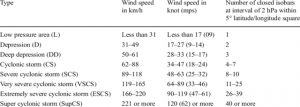
THE INDIAN SOCIAL ISSUES AND SOCIAL JUSTICE
AID OF SEX WORKERS
THE CONTEXT: The Supreme Court has reiterated its direction to States and Union Territories to supply dry rations to sex workers identified by the National AIDS Control Organisation and district legal authorities without insisting on the production of identity documents like ration cards.
THE EXPLANATION:
- The right to food has been recognised as a human right under Article 21 of the Constitution of India. Though there is some improvement in the situation caused by the COVID-19 pandemic, we are of the view that the constitutional obligation on the State governments and Union Territories to provide basic amenities to the citizens of this country takes into its fold that the sex workers are entitled to be provided dry ration”.
- One of the petitioners in the case, Durbar Mahila Samanway Committee, the country’s oldest collective of sex workers, had said sex workers were entitled to live with dignity with access to food, shelter and social protection. It said the pandemic had ravaged their lives and livelihoods and left the community impoverished.
- It explained that many in the community are single mothers unable to afford an education for their children in the current scenario. Attempts to secure alternative livelihoods have failed due to social stigma.
THE DURBAR MAHILA SAMANWAYA COMMITTEE
- Durbar, is a collective of 65,000 sex workers in West Bengal. Established on 15 February 1992, in Sonagachi, the largest red-light district in Kolkata, West Bengal, India with estimated 11,000 sex workers, Durbar has been working on women’s rights and sex workers’ rights advocacy, anti-human trafficking and HIV/AIDS prevention.
- Durbar states that its aims are the challenging and altering of the barriers that form the everyday reality of sex workers’ lives as they relate to their poverty or their ostracism.
- Durbar runs 51 free clinics for sex workers across West Bengal, with support from organisations such as the Ford Foundation and the National AIDS Control Organisation (NACO), who also help Durbar in its initiatives like networking, rights protection and creating alternative livelihood for sex workers.
| National AIDS Control Programme (NACP)
It is launched in 1992, is being implemented as a comprehensive programme for the prevention and control of HIV/ AIDS in India. Over time, the focus has shifted from raising awareness to behaviour change, from a national response to a more decentralized response and to increase involvement of NGOs and networks of people living with HIV (PLHIV). Objectives: · Reduce new infections by 50% (2007 Baseline of NACP III) · Provide comprehensive care and support to all persons living with HIV/AIDS and treatment services for all those who require it. |
THE INTERNATIONAL RELATIONS
CHINA LAUNCHES ITS FIRST CROSS-BORDER BRI TRAIN WITH LAOS
THE CONTEXT: China on Friday launched the first cross-border train of its multi-billion-dollar Belt and Road Initiative (BRI) from Laos, which Beijing says will help the small and only landlocked country in Southeast Asia turn into a land-linked hub, boost regional connectivity and supply chain resilience.

THE EXPLANATION:
- The first train of the China-Laos Railway left Vientiane soon after the cross-border railway was officially put into operation.
- Besides China, Laos shares borders with Vietnam, Thailand, Myanmar and Cambodia which offered Beijing to extend the train project to those countries.
- Laos is the only landlocked country in South East Asia. Like China, which is ruled by the Communist Party, it is a one-party socialist republic governed by the Lao People’s Revolutionary Party.
- The 1,035-km electrified passenger and cargo railway, connecting Kunming in southwest China’s Yunnan Province with Laos’ capital Vientiane, fully adopts Chinese technical standards and consists of two sections.
- China believes that the railway could help Laos turn its strategy of turning from a landlocked country to a land-linked hub into reality, boost regional connectivity and supply chain resilience, and make contributions to regional development and prosperity.
- The railway will also establish a rapid transit and commercial link between the Southeast Asian country and China, the world’s second-largest economy, powering Laos’ economic growth.
Background:
BRI:
- BRI consisting of the land-based belt, ‘Silk Road Economic Belt, and ‘Maritime Silk Road’, aims to connect the East Asian economic region with the European economic circle and runs across the continents of Asia, Europe, and Africa.
- BRI is China’s ambitious project announced in 2013. It covers about 65% of the world population, 60% of the world GDP and over 70 countries in six economic corridors.
- China is spending almost $1 trillion to revive and renew the overland and maritime trade links between China, Europe, West Asia, and East Africa through the construction of modern ports linked to high-speed road and rail corridors.
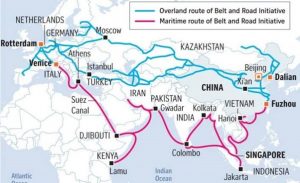
Concerns
- India argues that the BRI and China-Pakistan Economic Corridor project violates its sovereignty because it passes through the part of the Pakistan-occupied Kashmir that belongs to India.
- Debt trap: BRI projects are pushing recipient countries into indebtedness, do not transfer skills or technology and are environmentally unsustainable.
- China is planning to extend the CPEC to Afghanistan. Meanwhile, Maldives, Nepal, Myanmar and Sri Lanka are eagerly pursuing potential BRI projects.
- Through OBOR, China is countering the strategies of India in the North East region and is promoting its greater presence in North East India, part of which China claims as its own territory. This may have a security impact on India.
- The 99-year lease of the Hambantota port in Sri Lanka to China has raised red flags about the downside of the BRI and Beijing’s push for major infrastructure projects costing billions of dollars in smaller countries. However, the lack of transparency of the BRI agreements and mounting debt to China by smaller countries have raised global concerns.
THE INDIAN ECONOMY
NBFC’S BAD LOANS MAY RISE ON RBI NORMS
THE CONTEXT: The recent clarification by the Reserve Bank of India on non-performing advances (NPA) may increase non-banking financial companies’ (NBFC) bad loans by one third, says a report.
THE EXPLANATION:
- The RBI had provided clarification on income recognition asset classification and provisioning (IRAC) norms for banks, NBFCs and All-India Financial Institutions.
- Bad loans reported by non-banking financial companies (NBFCs) may rise after March 2022 as the Reserve Bank of India’s (RBI’s) latest clarification on upgradation of non-performing assets (NPAs) kicks in. Analysts said while banks have been following the new rule on upgrades, it will be a fresh start for most NBFCs.
- NBFCs generally classify an account as stage 3 when there is a payment overdue for more than 90 days and typically for monthly payments, this would be when there are three or more instalments overdue on any account.
- But when the borrower makes part payment such that the total overdue is less than three instalments, the account is removed from NPA classification and classified as a standard asset, although it remains in the overdue category in case not all dues are cleared.
- NBFC borrowers are generally a weak class of borrowers and have volatile cash flows which could mean that once an account has been classified as NPA, it could remain there for a considerable period as the ability to clear all dues may be constrained.
- Meanwhile, the RBI circular also calls for daily stamping of accounts to count the number of days they are overdues instead of a monthly or quarterly stamping.
BACKGROUND
What are Nonbank Financial Companies?
Nonbank financial companies (NBFCs), also known as nonbank financial institutions (NBFIs) are financial institutions that offer various banking services but do not have a banking license. Generally, these institutions are not allowed to take traditional demand deposits—readily available funds, such as those in checking or savings accounts—from the public.
In line with the international practices and as per the recommendations made by the Narasimham Committee on the Financial System, the Reserve Bank of India has introduced,
- prudential norms for income recognition,
- asset classification and provisioning for the advances portfolio of the banks
- to move towards greater consistency and transparency in the published accounts.
The policy of income recognition should be objective and based on the record of recovery rather than on any subjective considerations.
INCOME RECOGNITION AND ASSET CLASSIFICATION NORMS
- IRAC are rules that prescribe when a loan should be declared as a non-performing asset (NPA).
- Once a loan is an NPA, the RBI requires that any recovery should not be classified as income.
- Banks are also required to share information regarding large borrowers with the RBI for its Central Repository of Information on Large Credits (CRILC).
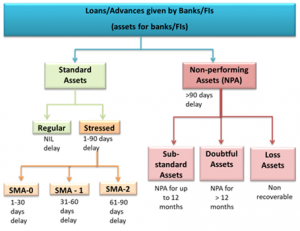
CENTRAL REPOSITORY OF INFORMATION ON LARGE CREDITS (CRILC)
- The RBI has set up a CRILC to collect, store, and disseminate credit data to lenders.
- CRILC is a borrower-level supervisory dataset that keeps the record of loans of Rs 5 crore and above.
- In India, there are four privately owned credit information companies (CICs).
- They are CIBIL, Equifax, Experian, and High Mark Credit Information Services.
- The RBI has also mandated all its regulated entities to submit credit information individually to all four CICs.
THE ENVIRONMENT AND ECOLOGY
INDIA REVOKES PEPSICO’S POTATO PATENT
THE CONTEXT: Two years after PepsiCo India provoked outrage by suing nine Gujarati farmers for allegedly infringing patent rights by growing its registered potato variety, the company’s registration of the variety has been revoked by the Protection of Plant Varieties and Farmers Rights’ Authority (PPV&FRA).
BACKGROUND:
- In 2019 the multi-billion-dollar conglomerate PepsiCo sued nine Gujarati farmers, asking them to pay ₹1.05 crore each as damages for ‘infringing its rights’ by growing the potato variety used in its Lays chips, farmers groups have launched a campaign calling for government intervention.
- Pepsi has sued the farmers for cultivating the FC5 potato variety, grown exclusively for its popular Lay’s potato chips. The FC5 variety has a lower moisture content required to make snacks such as potato chips.
Pepsico’s Stand:
- PepsiCo has invoked Section 64 of the Protection of Plant Varieties and Farmers’ Rights (PPV&FR) Act, 2001 to claim infringement of its rights.
- The section prohibits anyone other than the breeder of seeds or a registered licensee of that variety to sell, export, import or produces such variety.
- The farmers were allegedly growing a variety of potato namely FL 2027, also called FC5, on which PepsiCo claimed exclusive rights by virtue of a Plant Variety Certificate (PVC).
Farmers stand:
- However, farmers groups have said that section 39 of the Protection of Plant Varieties and Farmers’ Rights (PPV&FR) Act, 2001 allows farmers to grow and sell any variety of crop or even seed as long as they don’t sell branded seed of registered varieties.
- The farmers have requested the government to interfere on their behalf and ask Protection of Plant Varieties and Farmers’ Rights Authority (PPV&FRA) to make a submission in court and fund legal costs through the National Gene Fund.
THE PROTECTION OF PLANT VARIETIES AND FARMERS’ RIGHTS (PPV&FR) ACT, 2001
- In order to provide for the establishment of an effective system for the protection of plant varieties, the rights of farmers and plant breeders and to encourage the development of new varieties of plants it has been considered necessary to recognize and to protect the rights of the farmers in respect of their contributions made at any time in conserving, improving and making available plant genetic resources for the development of new plant varieties.
- The Govt. of India enacted “The Protection of Plant Varieties and Farmers’ Rights (PPV&FR) Act, 2001” adopting sui generis system. Indian legislation is not only in conformity with International Union for the Protection of New Varieties of Plants (UPOV), 1978, but also have sufficient provisions to protect the interests of public sector breeding institutions and the farmers.
- The legislation recognizes the contributions of both commercial plant breeders and farmers in plant breeding activity and also provides to implement TRIPs in a way that supports the specific socio-economic interests of all the stakeholders including private, public sectors and research institutions, as well as resource-constrained farmers.
Rights under the Act
- Breeders’ Rights : Breeders will have exclusive rights to produce, sell, market, distribute, import or export the protected variety. Breeder can appoint agent/ licensee and may exercise for civil remedy in case of infringement of rights.
- Researchers’ Rights : Researcher can use any of the registered variety under the Act for conducting experiment or research. This includes the use of a variety as an initial source of variety for the purpose of developing another variety but repeated use needs prior permission of the registered breeder.
Farmers’ Rights
- A farmer who has evolved or developed a new variety is entitled for registration and protection in like manner as a breeder of a variety;
- Farmers variety can also be registered as an extant variety;
- A farmer can save, use, sow, re-sow, exchange, share or sell his farm produce including seed of a variety protected under the PPV&FR Act, 2001 in the same manner as he was entitled before the coming into force of this Act provided farmer shall not be entitled to sell branded seed of a variety protected under the PPV&FR Act, 2001;
- Farmers are eligible for recognition and rewards for the conservation of Plant Genetic Resources of land races and wild relatives of economic plants;
- There is also a provision for compensation to the farmers for non-performance of variety under Section 39 (2) of the Act, 2001 and
- Farmer shall not be liable to pay any fee in any proceeding before the Authority or Registrar or the Tribunal or the High Court under the Act.
To implement the provisions of the Act the Department of Agriculture, Cooperation and Farmers Welfare, Ministry of Agriculture and Farmers Welfare established the Protection of Plant Varieties and Farmers’ Rights Authority on 11″ November, 2005.
National Gene Fund
- In 2007, the National Gene Fund was constituted under the PPV&FR Act 2001.
- It started with an initial amount of Rs 50 lakh from the Central government and gets a contribution from the money paid by plant breeders as registration and annual fee.
NEW BUTTERFLY SPECIES DISCOVERED
THE CONTEXT: The new species of butterfly, now named the Chocolate-bordered Flitter, also carries the scientific name Zographetus dzonguensis, after Dzongu in north Sikkim, the place where it was discovered.
THE EXPLANATION:
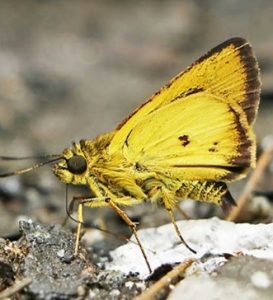
- Its closest relatives are Zographetus pangi in Guangdong, and Zographetus hainanensis in Hainan, both in southeastern China, close to Hong Kong, says Dr. Krushnamegh Kunte of NCBS.
- It is a golden yellow butterfly with brown borders and spots. The physical appearance of the species differ slightly and the internal structures of the males also differ slightly.
- It is mentioned on the ‘Butterflies of India’ website which is maintained by the National Centre for Biological Sciences (NCBS), Bengaluru.
BACKGROUND:
Butterfly
- Butterflies are insects from the order Lepidoptera of phylum Arthropoda which also includes moths.
- Adult butterflies have large, often brightly coloured wings, and conspicuous, fluttering flight.
Significance
- Rich Biodiversity: Abundance of butterflies in any area represents the rich biodiversity.
- Indicator Species: The butterfly acts as an indicator species.
- An indicator species provides information on the overall condition of the ecosystem and of other species in that ecosystem. They reflect the quality and changes in environmental conditions as well as aspects of community composition.
- Pollinator: It acts as a pollinator by helping in pollination and conserving several species of plants.
| National Centre for Biological Sciences (NCBS)
· It is headquartered in Bangalore, Karnataka, is a research centre specializing in biological research. · It is a part of the Tata Institute of Fundamental Research (TIFR) under the Department of Atomic Energy of the Government of India. · The mandate of NCBS is basic and interdisciplinary research in the frontier areas of biology. · The research interests of the faculty are in four broad areas ranging from the study of single molecules to systems biology. |
A LONG JOURNEY OF LESSER FLORICAN
THE CONTEXT: In a major discovery, the longest in-country migration route of lesser floricans, the endangered birds of the bustard group, has been tracked for the first time from Rajasthan to Maharashtra’s Ahmednagar district.
THE EXPLANATION:
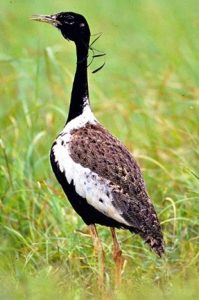
- The mystery of the fast-disappearing birds may soon be resolved with the help of satellite transmitters fitted on them.
- The telemetry exercise was undertaken in the Shokaliya landscape of Ajmer district to trace the journey of lesser floricans from their breeding grounds to their places of origin, presumably in down South.
- Following initial failures, the scientific experiment has succeeded in locating a bird which travelled a distance of 1,000 km after breeding during the monsoon.
- The endangered bird is observed in Rajasthan, Madhya Pradesh, Gujarat and some other regions during the monsoon season, when it breeds and later disappears with its chicks to unknown places.
- The bird is listed as “critically endangered” on the International Union for Conservation of Nature’s Red List of Threatened Species and its population has been identified as “decreasing”.
Lesser florican
- The lesser florican (Sypheotides indicus), also known as the likh or kharmore, is the smallest in the bustard family and the only member of the genus Sypheotides.
- It is endemic to the Indian Subcontinent where it is found in tall grasslands and is best known for the leaping breeding displays made by the males during the monsoon season.
- The male has a contrasting black and white breeding plumage and distinctive elongated head feathers that extend behind the neck. These bustards are found mainly in northwestern and central India during the summer but are found more widely distributed across India in winter.
- The species is highly endangered and has been extirpated in some parts of its range such as Pakistan. It is threatened both by hunting and habitat degradation.
- The only similar species is the Bengal florican (Houbarobsis bengalensis) which is larger and lacks the white throat, collar and elongated plumes.
| Bengal florican
The Bengal florican (Houbaropsis bengalensis), also called Bengal bustard, is a bustard species native to the Indian subcontinent, Cambodia, and Vietnam. It is listed as Critically Endangered on the IUCN Red List because fewer than 1,000 individuals were estimated to be alive as of 2017 |
THE MISCELLANEOUS
PENDENT: OLDEST SURVIVING JEWELLERY MADE BY HUMANS
THE CONTEXT: According to archaeologists, a newly discovered pendant carved from a woolly mammoth tusk could be the oldest surviving jewellery developed by humans. The pendant is dated 41,500 years old. The pendant was found in southern Poland inside the Stajnia cave.
THE EXPLANATION:
- The pendant from the Stajnia Cave has two holes drilled in it along with 50 other puncture marks (dots), the researchers reported in their research. Interestingly, the dots create a looping curve. However, the actual meaning of the
 se dots remains elusive. The researchers say that they may represent a counting system or a lunar observation, or something else. The radiocarbon dating has suggested that the mammoth tusk used to make the pendant was around 41,730 to 41,340 years ago. The awl was found to be 42,000 years old.
se dots remains elusive. The researchers say that they may represent a counting system or a lunar observation, or something else. The radiocarbon dating has suggested that the mammoth tusk used to make the pendant was around 41,730 to 41,340 years ago. The awl was found to be 42,000 years old.- This finding plays a unique role in demonstrating the importance of the direct date of an object of Paleolithic art to understand the origin of communication, celebration, and expression of Homo sapiens in Europe.
- The carbon dating has established that the pendant is thousands of years older than artefacts decorated similarly and found in other sites. In the Stajnia cave, the other objects found include an awl, a pointed tool used in making holes. The Stajina awl was 7-centimetre-long and carved from a horse bone.
What is Carbon Dating?
Radiocarbon dating or carbon dating or carbon-14 dating is a method for determining the age of an object containing organic material by using the properties of radiocarbon a radioactive isotope of carbon. Unstable carbon-14 gradually decays to carbon-12 at a steady rate
How it works?
- Radiocarbon dating works by comparing the three different isotopes of carbon. Isotopes of a particular element have the same number of protons in their nucleus, but different numbers of neutrons. This means that although they are very similar chemically, they have different masses.
- The total mass of the isotope is indicated by the numerical superscript. While the lighter means its nucleus is so large that it is unstable.
THE PRELIMS PRACTICE QUESTIONS
Q1. Which among the following steps is most likely to be taken at the time of an economic recession?
a) Cut in tax rates accompanied by increase in interest rate.
b) Increase in expenditure on public projects.
c) Increase in tax rates accompanied by reduction of interest rate.
d) Reduction of expenditure on public projects.
ANSWER FOR DECEMBER 03rd 2021 PRELIMS PRACTICE QUESTIONS
ANSWER: C
EXPLANATION: Ishwar Chandra Vidyasagar was the secretary of Bethune school established in 1849 also known as Hindu female school. He was one of the pioneers of higher education for women in India.
Spread the Word
 se dots remains elusive. The researchers say that they may represent a counting system or a lunar observation, or something else. The radiocarbon dating has suggested that the mammoth tusk used to make the pendant was around 41,730 to 41,340 years ago. The awl was found to be 42,000 years old.
se dots remains elusive. The researchers say that they may represent a counting system or a lunar observation, or something else. The radiocarbon dating has suggested that the mammoth tusk used to make the pendant was around 41,730 to 41,340 years ago. The awl was found to be 42,000 years old.